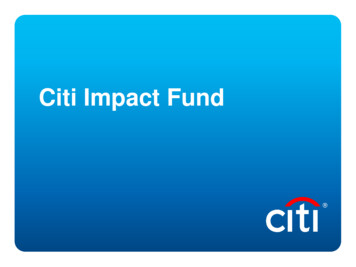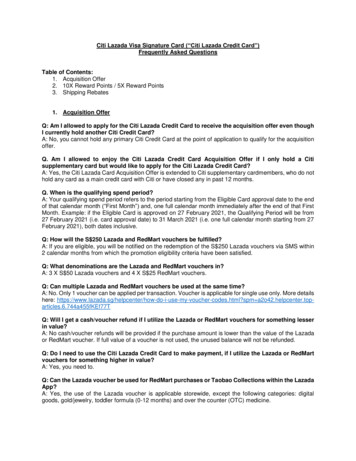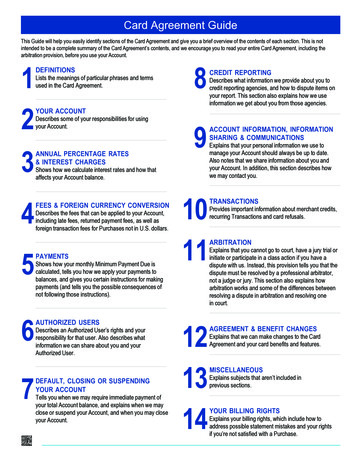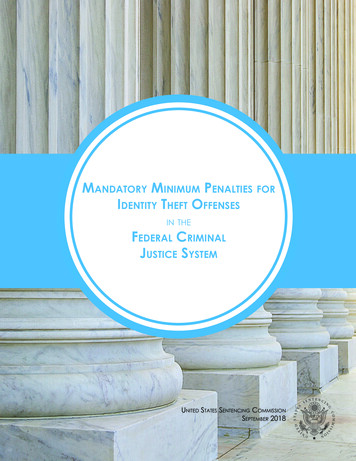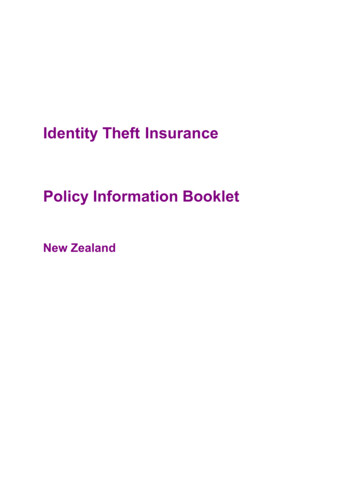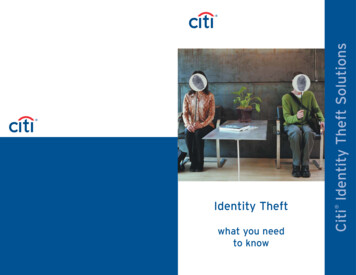
Transcription
Citi Identity Theft Solutionswhat you needto know Identity Theft
At Citi, we want to keep you informed about allof the issues that can affect your financial life.We’re bringing you helpful informationprovided to us by the Federal TradeCommission on how to protect yourself againstidentity theft and what to do if you become avictim. For more on credit card safety andfraud prevention tips, visit our websitewww.UseCreditWisely.com.What is identity theft?CONTENTSPAGEWhat is identity theft?3How can someone steal my identity?4Fraudulent use of your personal information5Protecting yourself against identity theft6How can I tell if I’m a victim of identity theft?7Dealing with identity theft8Reclaiming your identity14Resolving identity theft-related credit problems16Sample dispute letter20Important information and contacts23?Identity theft happens when someoneaccesses essential elements of a person’sidentifying information in order to committheft. This information includes name, address,Social Security number, date of birth andmother’s maiden name. Many identity thievesuse this personal information in order to opencredit card accounts, obtain loans and evenmortgages in the victim’s name.3
How can someone steal my identity?Fraudulent use of your personalinformationIdentity thieves may use a variety of methods to gain access toyour personal information, such as:Once thieves steal your personal information, they assumeyour identity to commit fraud, such as: Stealing personal information from your home. Getting information from businesses or institutions by:stealing records from their employer,bribing an employee who has access to the records, Call your card issuer; ask to change the mailing addresson your card account and request that a new card be sentto the new address. The imposter then runs up charges onyour account. Open a new credit card account, using your name, date ofbirth and Social Security number.conning information out of employees, or Establish phone or wireless service in your name.hacking into the organization’s computers. Open a bank account in your name to write bad checks. Rummaging through your trash, the trash of businesses, ordumps in a practice known as “dumpster diving.” Obtaining credit reports by abusing their employer’s authorizedaccess to credit reports or by posing as a landlord, employer orsomeone else who may have a legitimate need for and a legalright to the information. Stealing wallets and purses. Stealing mail, including bank and credit card statements, preapproved credit offers, new checks, or tax information. Completing a “change of address form” to divert mail toanother location. Obtaining information directly from you by posing as alegitimate businessperson or government official.4 File for bankruptcy under your name to avoid payingdebts they’ve incurred under your name or to avoideviction. Buy cars by taking out auto loans in your name. Give your name to the police during an arrest.
Protecting yourselfagainst identity theftYou can reduce your risk and safeguard your identifyinginformation by following some simple guidelines. Protect your mailbox: Remove your mail as soon afterdelivery as possible. Also, deposit outgoing mail in postoffice collection boxes or at your local post office to lowerthe risk of identity theft happening to you.How can I tell if I’m a victim ofidentity theft?An identity thief can strike even if you’ve been verycareful with your personal information. Someindications of identity theft may include: Protect your wallet: Keep items with personalinformation in a safe place at home and do not share thisinformation with friends or acquaintances. Don’t carryyour Social Security card in your wallet or purse.Memorize your Social Security number and never write itdown on anything you carry. Destroy all of your receiptswhen you no longer need them. Failing to receive bills or other mail signaling anaddress change by the identity thief; Receiving cards or billing statements for accounts Protect your credit and debit cards: Whenever youreceive a new card, sign it immediately. Never loan yourcard to anyone, under any circumstance. Notify your bankand other issuers when you change your address or phonenumber and be sure to report all lost or stolen cardsimmediately. Never put your account number on theoutside of any envelope.for which you did not apply; Receiving calls from debt collectors of companiesabout merchandise or services you didn’t buy.If you think you may be a victim, you can obtain acopy of your credit report from each of the threemajor credit bureaus listed on page 23. If it’saccurate and includes only those activities you’veauthorized, chances are you’re not a victim ofidentity theft.7
Immediately close your existing unauthorized Citi cardaccount to prevent further unauthorized charges andopen a new card account for you. Assist you in contacting a credit bureau to check yourcredit report for fraudulent activity. The credit bureau willthen place a “Fraud Alert” on your files at all three creditbureaus.Dealing with identity theftIf you suspect that your personal information has beenstolen to commit fraud or theft, Citi can help. As a Citicard customer, you can automatically use the freeservices of Citi Identity Theft Solutions, even if the fraudoccurred on a card from another issuer. At Citi, weconstantly safeguard and protect your identity bymonitoring your card account for any suspicious activity,often identifying fraud before you are aware — or the thiefdoes damage. However, personal information can bestolen even without your card. Our team of Identity TheftSolutions specialists will provide personal support andassistance through the process of re-establishing yourcredit. T hey are available to you at 1-800-950-5114.When you call to report fraudulent activities on your Citicard account or a card account that has been fraudulentlyopened in your name, we will begin an investigationimmediately. Once it has been established that you are avictim of identity theft, a Specialist will be assigned toyour case and work with you for the duration of theinvestigation. The Specialist will work with you tostreamline and simplify the steps to reclaiming youridentity, such as: Provide advice and information about contacting othercreditors for your other card accounts or to close otherunauthorized card accounts. Help you understand how to complete/submit a policereport as well as other government related forms thatmay be necessary for submission, depending upon thespecifics of your case. Continue to monitor your credit bureau report andnotify you quickly if any more fraud is detected until yourcase is closed. Continue to keep in touch with you about the status ofyour card account until the case is closed.If you choose to handle this situation yourself, take actionimmediately, and keep a record of your conversations andcorrespondence. Exactly which steps you should take toprotect yourself depends on your circumstances and howyour identity has been misused. However, four basicactions are appropriate in almost every case.9
Step 1: Contact the fraud departments of each of thethree major credit bureaus. Equifax1-800-525-6285 Experian1-888-397-3742 TransUnion1-800-680-7289Tell them that you’re an identity theft victim. Request that a“fraud alert” be placed in your file, as well as a “victim’sstatement” asking that the creditors call you before opening anynew accounts or changing your existing accounts. This can helpprevent an identity thief from opening additional accounts in yourname.At the same time, you will need to order copies of your creditreport. If your requests are made in writing, credit bureaus arerequired to give you a free copy of your report if your report isinaccurate because of fraud (Contact information provided onpage 23). Review your reports carefully to make sure noadditional fraudulent accounts have been opened in your name orunauthorized charges have been made to your existing accounts.Check that information such as your Social Security number,address(es), name, and employers are correct. Also, check thesection of your report that lists “inquiries.” If “inquiries” appearfrom the company(ies) that opened the fraudulent account(s),request that these inquiries be removed from your report. In a fewmonths, you should order new copies of your credit reports toverify that your corrections and changes have been made, and tomake sure no new fraudulent activity has occurred.Step 2: Close any accounts that have been tamperedwith or opened fraudulently.Credit AccountsCredit accounts include all accounts with banks, credit cardcompanies and other lenders, and phone companies, utilities, InternetService Providers (ISPs), and other service providers. Ask to speakwith someone in the security or fraud department of each creditorand follow up with a letter. It’s particularly important to notify creditcard companies in writing because that’s the consumer protectionprocedure the law spells out for resolving errors on credit card billingstatements.If there are fraudulent charges, ask the company about forms fordisputing those transactions. Immediately close accounts that havebeen tampered with and open new ones with new PersonalIdentification Numbers (PINs) and passwords.ChecksIf your checks have been stolen or misused, close the account andask your bank to notify the appropriate check verification service.While no federal law limits your losses if someone steals your checksand forges your signature, state laws may protect you.You also should contact these major check verification companiesdirectly for the following services: To request that they notify retailers who use their databases not toaccept your checks, call:Certegy, Inc.1-800-437-5120Global Payments1-800-766-2748TeleCheck1-800-710-9898 To find out if an identity thief has been passing bad checks in yourname, call:SCAN1-800-262 777111
Step 3: File a police report with your localpolice or the police in the community where theidentity theft took place.Even if the police can’t catch the identity thief, having acopy of the police report can help you when dealing withcreditors. Local authorities may tell you that they can’ttake a report. S tress the importance of a police report;many creditors require one to resolve your dispute. If y oucan’t get the local police to take a report, try your countysheriff. If that doe sn’t work, try your state police or statelaw enforcement authorities. If you’re told that identitytheft is not a crime under your state law, ask to file aMiscellaneous Incident Report instead.“Once thieves steal yourpersonal information, theyassume your identity tocommit fraud.Get a copy of the police report in case the bank, creditcard company or others need proof of the crime. If youcan’t get a copy, at least get the report number.Step 4: File a complaint with the Federal TradeCommission (FTC)Contact the FTC’s Identity Theft Hotline by telephone:1-877-IDTHEFT (438-4338); TDD: 202-326-2502; onlineat www.consumer.gov/idtheft; or by mail at Identity TheftClearinghouse, Federal Trade Commission, 600Pennsylvania Avenue NW, Washington, DC 20580. T heFTC enters complaints into a secure consumer frauddatabase, accessible only to law enforcement agencies,for use in pursuing criminal investigations.13
Reclaiming your identityThe following steps can help you straighten out thedamage done by identity theft.Stolen Mail: If an identity thief has stolen your mail toget new credit cards, bank and credit card statements,pre-screened credit offers or tax information, or if anidentity thief has falsified change-of-address forms, that’sa crime. Report it to your local postal inspector.Change of Address on credit or debit cardaccounts: If you discover that an identity thief haschanged the billing address on an existing account, closethe account. When you open a new account, ask that apassword be used before any inquiries or changes can bemade on the account.Bank Accounts: If you have reason to believe that anidentity thief has tampered with your bank accounts,checks or ATM card, close the accounts immediately.When you open new accounts, insist on password-onlyaccess to minimize the chance that an identity thief canviolate the accounts. If your ATM card has been lost,stolen or otherwise compromised, cancel the card as soonas you can and get another with a new PIN.Investments: If you believe that an identity thief hastampered with your securities investments or brokerageaccount, immediately report it to your broker or accountmanager and to the Securities and Exchange Commission,202-942-8088.Phone or wireless service: If an identity thief hasestablished new phone or wireless service in your name; ismaking unauthorized calls that appear to come from - and arebilled to - your cellular phone; or is using your calling card andPIN, contact your service provider immediately to cancel theaccount and/or calling card. Open new accounts and choosenew PINs.Employment: If someone is using your Social Securitynumber to apply for a job or to work, that’s a crime. Report it tothe Social Security Administration’s Fraud Hotline at 1-800 269-0271.Driver’s license: If you suspect that your name or SocialSecurity number is being used by an identity thief to get adriver’s license or a non-driver’s ID card, report it to yourDepartment of Motor Vehicles. If your state uses your SocialSecurity number as your driver’s license number, ask tosubstitute another number.Bankruptcy: If you believe someone has filed for bankruptcyusing your name, write to the U.S. Trustee in the region wherethe bankruptcy was filed. A listing of the U.S. Trustee Program’sregions can be found at www.usdoj.gov/ust or look in the BluePages of your phone book under U.S. Government BankruptcyAdministration.Criminal records/arrests: In rare instances, an identitythief may create a criminal record in your name. For example,your imposter may give your name when arrested. If thishappens to you, you may need to hire an attorney to helpresolve the problem. Contact a lawyer in your state or area (youmay want to contact your local bar association for help infinding an attorney).15
Resolving identity theftrelatedcredit problemsResolving credit problems resulting from identity theftcan be time-consuming and frustrating. The good newsDealing with credit bureausTo protect your rights under the law, contact both thecredit bureau and the information provider. First, call thecredit bureau and then follow up in writing. Tell themis that there are federal laws that establish procedureswhat information you believe is inaccurate. Includefor correcting credit report errors and billing errors,copies (NOT originals) of documents that support yourand for stopping debt collectors from contacting youposition. In addition to providing your complete nameabout debts you don’t owe.and address, your letter should clearly identify each itemin your report that you dispute, give the facts and explainThe Fair Credit Reporting Act (FCRA) establishesprocedures for correcting mistakes on your creditrecord. Under the FCRA, both the credit bureau andwhy you dispute the information, and request deletion orcorrection. You may want to enclose a copy of yourcredit bureau report with circles around the items inquestion.the organization that provided the information to thecredit bureau (the “information provider”), such as aSend your letter by certified mail, and request a returnbank or credit card company, are responsible forreceipt so you can document what the credit bureaucorrecting inaccurate or incomplete information inreceived and when. Keep copies of your dispute letteryour report.and enclosures.Credit bureaus must usually investigate the items inquestion within 30 days. They also must forward allrelevant data you provide about the dispute to theinformation provider. After the information providerreceives notice of a dispute from the credit bureau, itmust investigate, review all relevant information providedby the credit bureau, and report the results to the creditbureau.17
If an item is incomplete, the credit bureau mustIf the information provider finds the disputed informationcomplete it.to be inaccurate, it must notify any nationwide creditbureau that it reports to so that the credit bureau can If your file shows an account that belongs to someonecorrect this information in your file. Note that:else, the credit bureau must delete it. Disputed information that cannot be verified must bedeleted from your file. If your report contains erroneous information, the creditbureau must correct it.When the investigation is complete, the credit bureaumust give you written results and a free copy of yourreport if the dispute results in a change. If an item ischanged or removed, the credit bureau cannot put thedisputed information back in your file unless theinformation provider verifies its accuracy andcompleteness, and the credit bureau gives you a writtennotice that includes the name, address and phonenumber of the information provider.If you request a correction, the credit bureau must sendnotices of the corrections to anyone who received yourreport in the past six months. Job applicants can have acorrected copy of their report sent to anyone whoreceived a copy during the past two years foremployment purposes. If an investigation does notresolve your dispute, ask the credit bureau to includeyour statement of the dispute in your file and in futurereports.19
Dealing with creditors/information providersIn addition to writing to the credit bureau, tell the creditor or other information providers in writing that you dispute an item (see sampledispute letter below). Again, include copies (NOT originals) of documents that support your position. If the information provider thenreports the item to any credit bureau, it must include a notice of your dispute. In addition, if you are correct - that is, if the disputedinformation is not accurate - the information provider must not use it again.Sample Dispute LetterThis is a sample letter that you can use to dispute false or inaccurate information on your credit report. Areas highlighted initalics should be changed to fit your personal situation.DateYour NameYour AddressYour City, State, Zip CodeComplaint DepartmentName of Credit BureauAddressCity, State, Zip CodeDear Sir or Madam:I am writing to dispute the following information in my file. The items I dispute also are circled on the attached copy of the report Ireceived. (Identify item(s) disputed by name of source, such as creditors or tax court, and identify type of item, such as credit account,judgment, etc.)This item is (inaccurate or incomplete) because (describe what is inaccurate or incomplete and why). I am requesting that the item bedeleted (or request another specific change) to correct the information.Enclosed are copies of (use this sentence if applicable and describe any enclosed documentation, such as payment records, courtdocuments) supporting my position. Please investigate this (these) matter(s) and (delete or correct) the disputed item(s) as soon aspossible. Please confirm to me in writing when this has been completed.Sincerely,(Your name)Enclosures: (List what you are enclosing.)
This page has been intentionally left blankiIImportantmportant iinformationnformation aandnd ccontactsontactsCiti Credit CardsFor assistance, call the number on the backof your card, or call 1-800-950-5114.CitiPhoneBanking For assistance, call the number on the backof your card, or call 1-800-274-6660.Stolen Checks or Fraudulent BankAccountsIf your checks are stolen or you believeyour bank account has been compromised,you should call each of the followingcompanies:Certegy, Inc.1-800-437-5120Global -800-262-7771Federal Trade Commission (FTC)Identity Theft Clearing House600 Pennsylvania Avenue NWWashington, DC 20580www.consumer.gov/idtheft1-877-IDTHEFTSocial Security Administration’sFraud HotlineP.O. Box 17768Baltimore, MD 21235www.ssa.gov/oig1-800-269-027122U.S. Postal Inspectorwww.usps.gov/websites/depart/inspect See your local telephonedirectoryCredit BureausEquifaxTo report fraud, call 1-800-525-6285,and write:P.O. Box 740241Atlanta, GA 30374-0241www.econsumer.equifax.comFor a credit report call 1-800-685-1111ExperianTo report fraud, call 1-888-397-3742,and write:P.O. Box 9532Allen TX, 75013www.experian.com/consumerFor a credit report call 1-888-397-3742TransUnionTo report fraud, call 1-800-680-7289,and write:Fraud Victim Assistance DivisionP.O. Box 6790Fullerton, CA 92834-6790www.transunion.comFor a credit report call 1-800-916-8800
olen to commit fraud or theft, Citi can help. As a Citi ca rd customer, you can automatically use the free s ervices of Citi Identity Theft Solutions, even if the fraud occurred on a card from another issuer. At Citi, we c onstantly safeguard and protect your identity by monitoring your card account for any suspicious activity, oft
